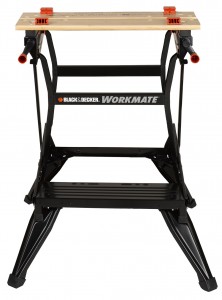Workbenches
Workbenches can often divide opinion in the DIY world. Some DIYers look upon them as the equivalent to a dishwasher in a kitchen, as they can’t imagine what life was like before having one. Others are very happy resting stuff on the end of garden benches, steps, or grovelling around on the floor with a couple of lengths of wood for support. Personally, I have a foot in both camps, and it does depend on the particular job at hand, but if you are thinking of investing in a new collapsible workbench, here are a few points to consider that should help in your deliberations.
Black and Decker workbenches

The Black and Decker Workmate is definitely the ‘Daddy’ of all workbenches, but there are certainly cheaper options out there for DIY use.
Like the name or not, no workbench choice can be made without talking about the all time classic Black and Decker workbenches. They were the first, and still have a huge market share, but at some stage in the 90s, competitors started producing their own designs, and now you can buy a number of variations of what is essentially the original Black and Decker template.
If you decide to opt for a Black and Decker Workmate, you’re not going to be disappointed with its sturdiness and ability to do the job. They also have a number of model variations so you certainly don’t have to pay above three figures unless you want to consider the all singing, all dancing top of the range models which are pretty heavy duty, and really designed for the on site carpenter, rather than for DIY use.
The only problem with Black and Decker Workmates, and it may just be me, but I’ve never found them to be the easiest to fold up and store. I’ve used a number of different models, and I always find that at least one of the inward folding feet loosens off and flops around when you try to put it away. Also within the brilliantly designed catch mechanism, for actually folding the table down, I’ve never been able to master the technique for smooth operation, and have therefore experienced more than one finger injury attempting to collapse the workmate at the end of the day. Perhaps I lack a bit of patience, but when I casually survey Workmate use ‘on site’, I do tend to see a few chippies banging away at different parts of the workbench, trying to pack it away into an already full van. So, I do think there are other options.
Cheap workbenches
For me, the surprising thing about the options to the Black and Decker workbenches is that not only are they generally much cheaper, but most seem to work pretty well. I’ve assembled and used all manner of cheaper worbenches for either photographic purposes, or for general practical use and it always amazes me that although they are often lightweight in design, they do seem to do the ‘job’. Also because they are undoubtedly flimsier than the Black and Decker, this fact alone means that their folding down mechanism is very simple, and for me, less likely to fail, wear out, or lead to a nasty finger pinching wound. I should add that Black and Decker do also have a lighter design of workbenchavailable, and particularly well reviewed, on Amazon amongst other outlets. It does approach the low price threshold, and indeed does employ a simpler closing up system, but I think you can still go cheaper for DIY purposes.
My workbench choice
I hope this guide hasn’t come across as too critical of Black and Decker as if I had the space to leave my workbench ‘up’ all the time, I would choose one of their sub £100 models, as they are still the sturdiest and best overall design. However, for occasional DIY use and foldaway ease, I wouldn’t look much further than the Lightweight Workbench, available at Screwfix. For that sort of money, you’ll struggle to find better value, with the Draper 09951being the only real competition at this level. Happy deliberations, and mind those fingers.
